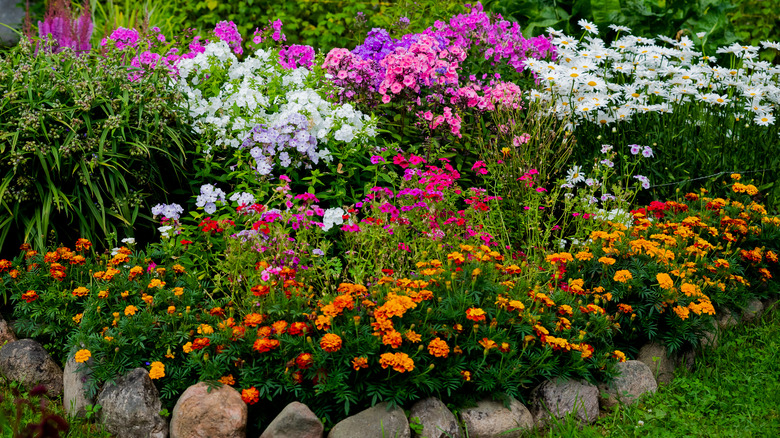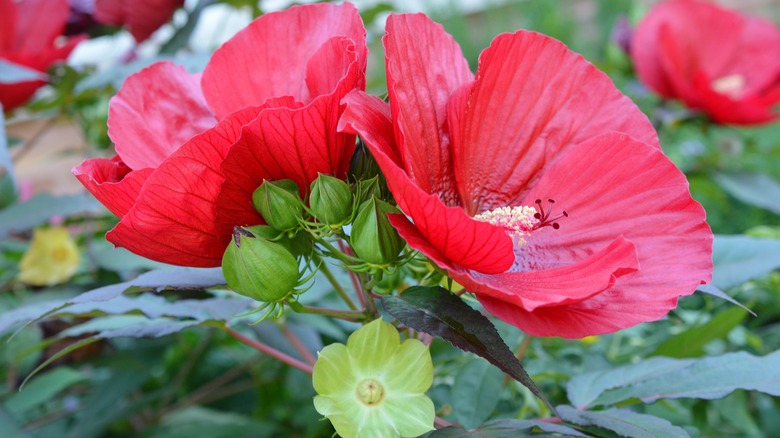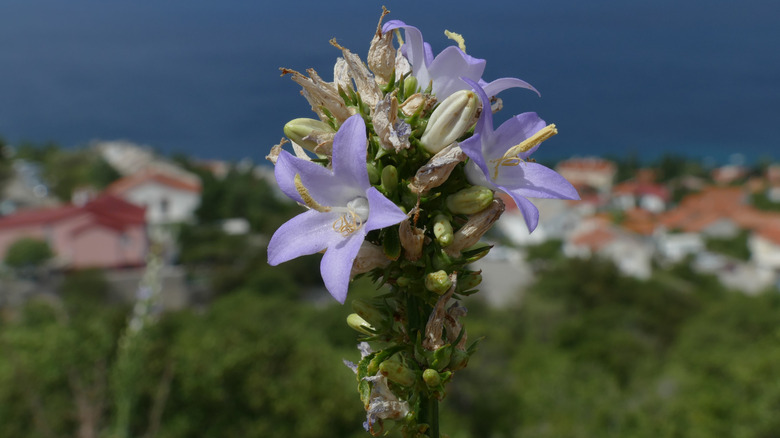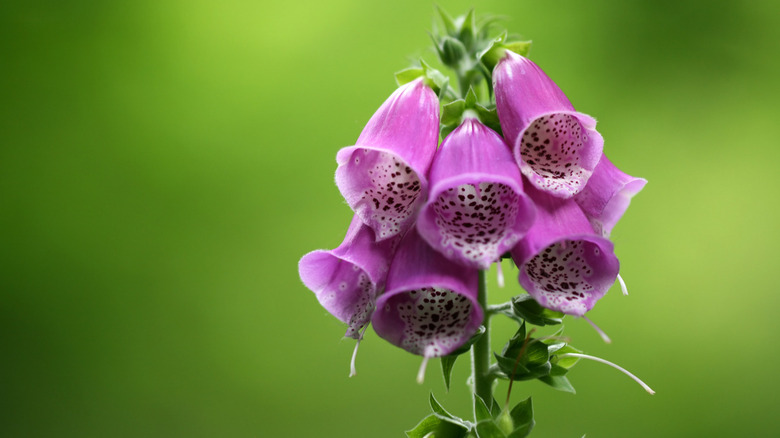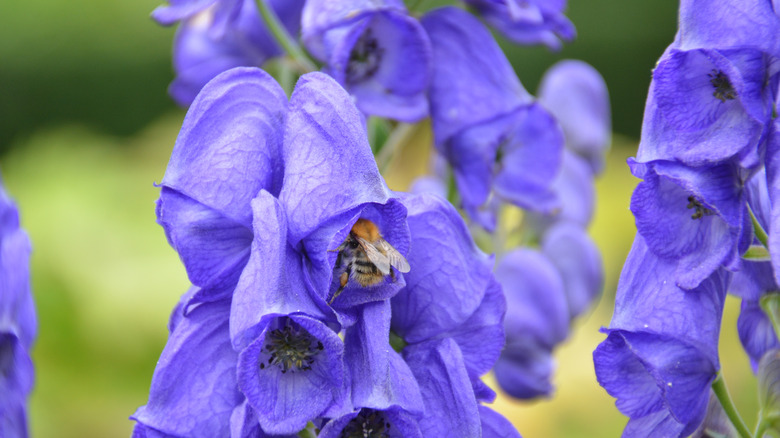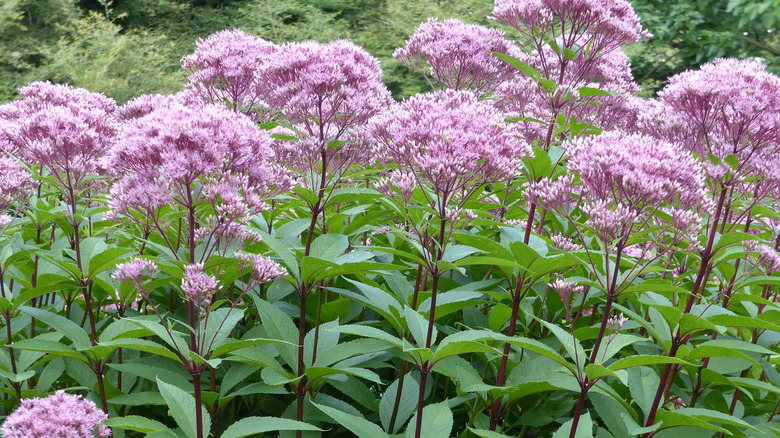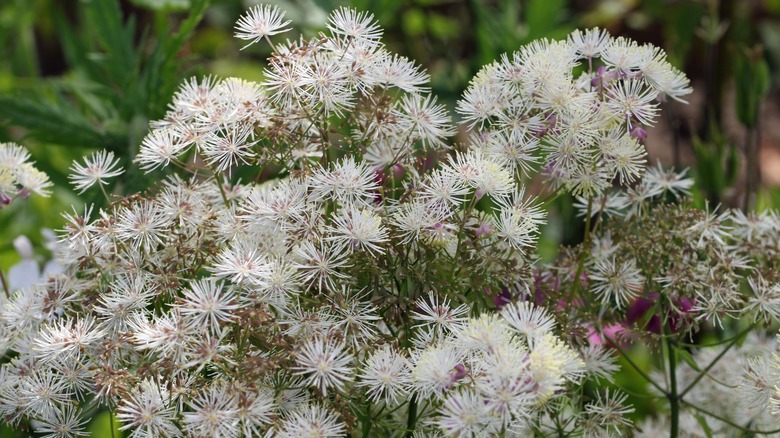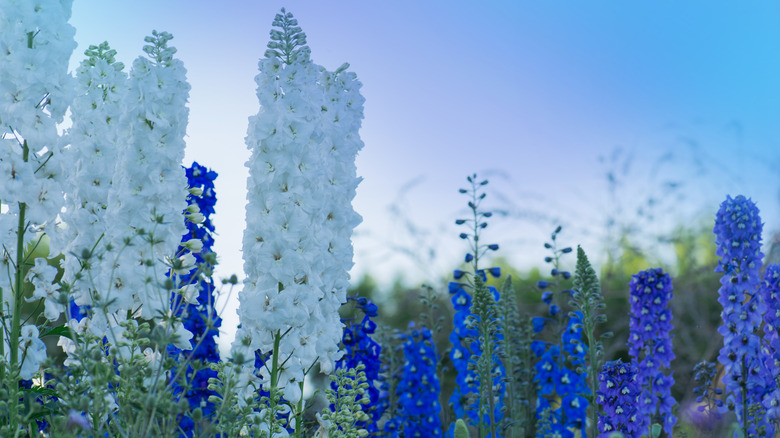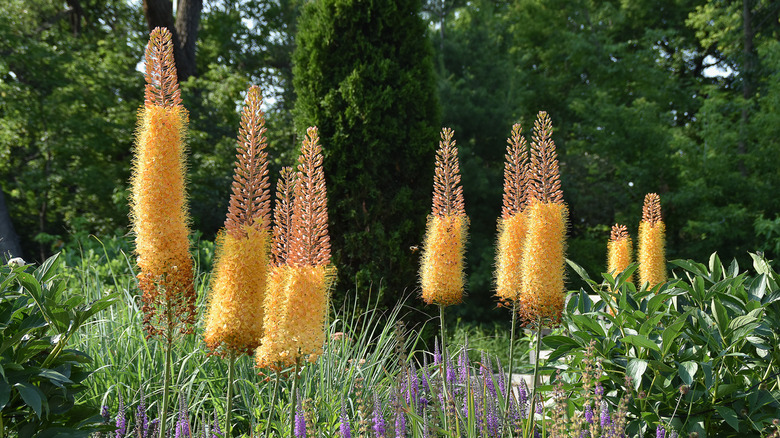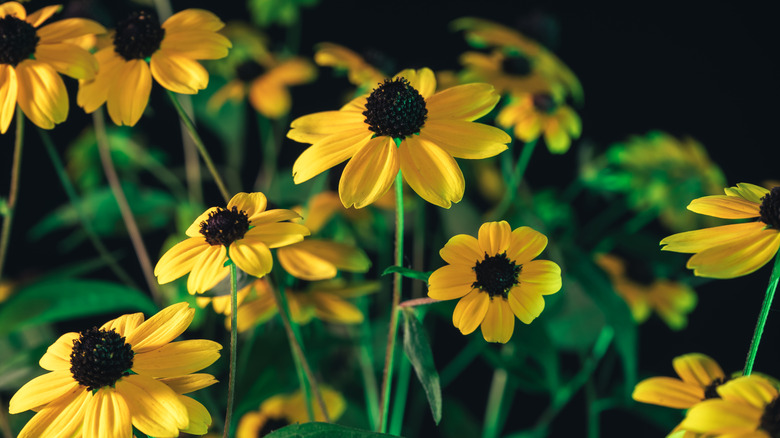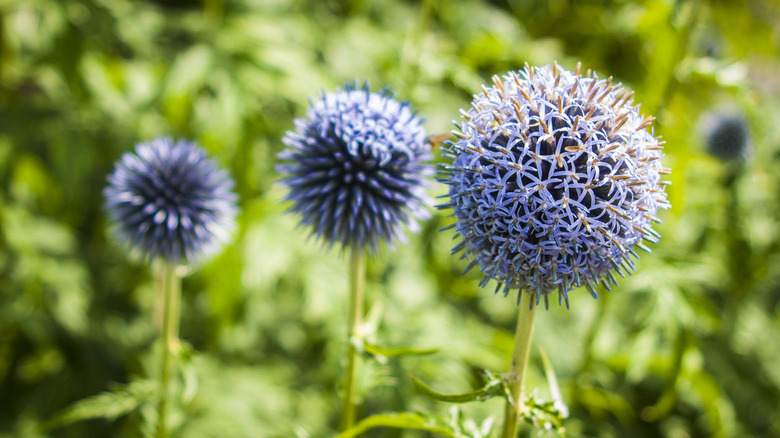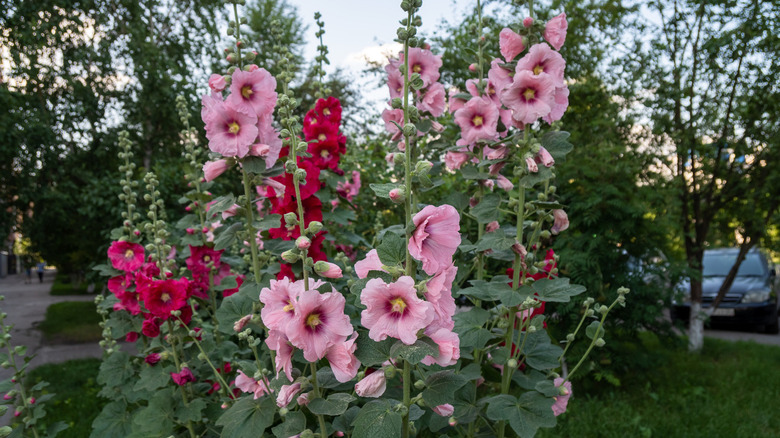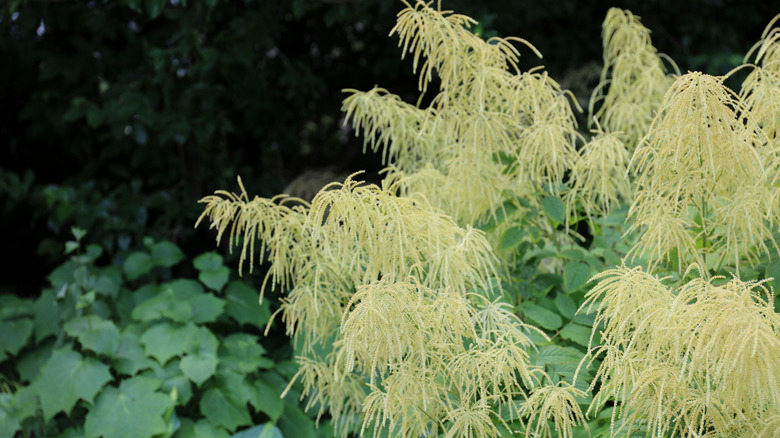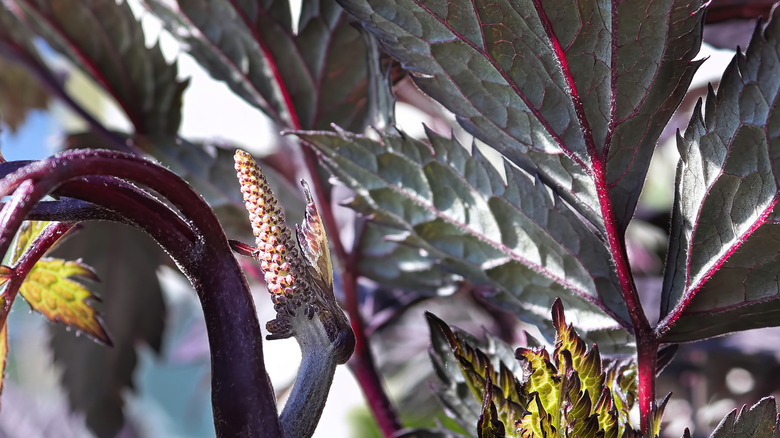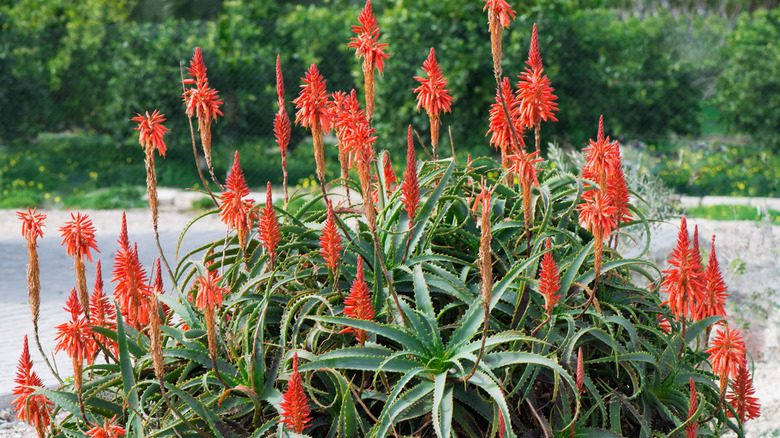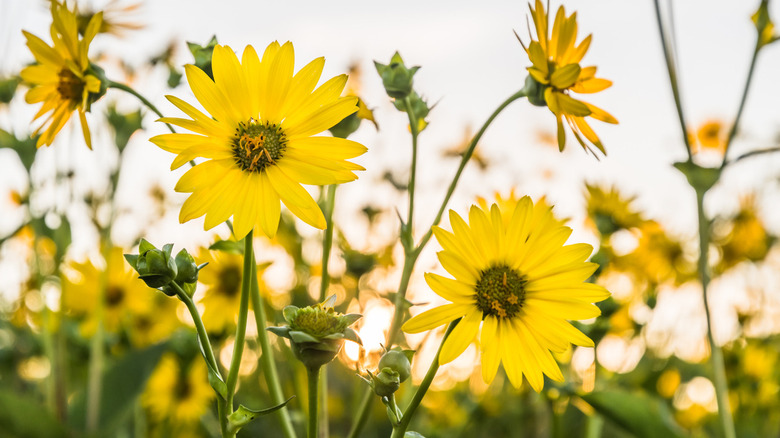15 Perennial Flowers That Will Grow Tall In Your Garden
Are you looking to add vertical interest to your garden? Planting perennial flowers will help you achieve just that. Tall perennials have plenty of benefits to an outdoor garden. While they are predominantly grown for their aesthetic appeal, these plants look amazing at the back of borders. They are tall enough to add pomp and color to unsightly fences every time they bloom. According to the Texas Cooperative Extension, what makes tall perennial flowers quite remarkable is that they return year after year, not to mention that, unlike smaller perennial flowers, you will be able to appreciate their beauty from afar.
While taking care of perennials might come with a few challenges, it is worth mentioning that they will surely transform the appeal of any flower garden. There are plenty of perennial flowers that grow tall and also bloom at different times of the year. With a bit of creativity and organization, you can create your own outdoor paradise with flowers that bloom all year round. Here is a list of perennial flowers that grow tall and bloom with beautiful colors.
1. Hardy hibiscus
The hardy hibiscus (Hibiscus moscheutos) is the perfect plant to introduce a tropical vibe to your garden. They are famous for their large, showy flowers in several colors: white, magenta, red, and pink. Since they grow tall, the Texas Cooperative Extension advises that you should plant this flower in rich soil to facilitate rapid growth. Despite its delicate appearance, Hibiscus moscheutos is cold, hardy, and surprisingly easy to care for.
Bloom Season: Summer
USDA Growing Zone: 5 to 9
Growing Conditions: Full sun exposure
Soil Type: Rich organic, neutral pH
Size: 3 to 7 feet tall, 2 to 4 feet wide
2. Chimney bellflower
The Chimney Bellflower (Campanula Pyramidalis) is a tall perennial known for its spike-shaped lavender flowers. It will make a great addition to your flower bed as a mid or border plant. This flower is self-fertilizing; therefore, you need not worry about helping it blossom, via Plants For A Future. However, the chimney bellflower does not bloom in the first year and is a short-lived perennial.
Bloom Season: Summer
USDA Growing Zone: 7 to 10
Growing Conditions: Full sun exposure
Soil Type: Rich, well-draining
Size: up to 5 feet tall, 2 feet wide maximum
3. Common foxglove
If you intend to add vertical interest to your flower garden, you can never go wrong with the Common foxglove (Digitalis purpurea). This plant blooms in a series of downfacing tubular bell-shaped flowers. The flowers transform into small, fruit-forming seeds that break open, releasing them to grow into lovely colonies, via the University of Wisconsin-Madison Division of Extension.
Bloom Season: Spring and summer
USDA Growing Zone: 3 to 8
Growing Conditions: Full to partial exposure
Soil Type: Well-drained soil
Size: 2 to 6 feet tall and up to 2 feet wide
4. Monkshood
The Monkshood (Aconitum napellus), also known as devil's helmet, is a tall perennial plant that loves the shade. True to its name, this plant blooms into a peculiar-looking flower resembling monks with huge hoods, via the American Association of Clinical Chemistry. The monkshood plant is available in several varieties but the Aconitum napellus is popular for its ornamental value.
Bloom Season: Summer
USDA Growing Zone: 3 to 8
Growing Conditions: Partial shade
Soil Type: Moist, well-drained soil
Size: Up to 8 feet tall and up to 1 feet wide
5. Joe pye weed
The Joe Pye Weed (Eutrochium maculatum) is another worthy addition to your garden. Its impressive, showy display of colorful clamps of purple, vanilla-scented flowers will light up your garden and attract butterflies. The thick stems grow upright, and the serrated leaves are also eye-catching. It is a fast grower and often flowers within the first season, via the North Carolina Extension Gardener Plant Toolbox.
Bloom Season: Summer
USDA Growing Zone: 4 to 9
Growing Conditions: Full to partial exposure
Soil Type: Well-drained soil
Size: 4 to 7 feet tall, 4 to 8 feet wide
6. Meadow rue
Meadow Rue (Thalictrum SPP) is a perennial flower that grows quite tall under the right conditions. Its central stem ends in a large snow-flake-like floral pinnacle that can take different colors, depending on the variety. This herbaceous plant will look good at the back of the garden or as a screen, via the North Carolina Extension Gardener Plant Toolbox.
Bloom Season: Spring or summer
USDA Growing Zone: 3 to 7
Growing Conditions: Full to partial exposure
Soil Type: Rich, well-drained acidic
Size: 1 to 8 feet tall, 1 to 5 feet wide
7. Delphinium
Bold and beauty are the perfect terms to describe the Delphinium (Delphinium elatum), also known as sweethearts. This plant blooms into dense showy flower spikes, and the Missouri Botanical Garden advises that you should cut the blossoms to allow for later flowering during late fall. This plant requires delicate care to remain upright, especially in strong wind.
Bloom Season: Early summer to fall
USDA Growing Zone: 3 to 7
Growing Conditions: Full sun exposure
Soil Type: Moist, well-drained soil
Size: 3 to 5 feet tall, 2 to 3 feet wide
8. Foxtail Lily
Desert candle or Foxtail Lily (Eremurus spp.) is a tuberous plant that blooms into elegant spike-shaped flowers. The long stems and spikes-shaped leaves are quite architectural and look fabulous on a dark backdrop, such as green foliage. They will create a dramatic candlelight pathway if grown along the edge of your garden or footpaths. With proper care, this plant will reward you with colorful flowers when the time is right, via Chicago Botanic Garden.
Bloom Season: Spring and summer
USDA Growing Zone: 5 to 8
Growing Conditions: Full sun
Soil Type: Well-drained soil
Size: Up to 10 feet, 1 to 2 feet wide
9. Black-eyed Susan
Are you interested in golden summer blooms? Then the Black-eyed Susan (Rudbeckia Hirta) is ideal for you. The yellow flowers come to life during summer and are busy with pollination activities from birds and insects. The University of Kentucky Cooperative Extension mentions that this flower is self-sowing and can spread in the garden; therefore, you should be mindful of where you plant it.
Bloom Season: Summer
USDA Growing Zone: 3 to 9
Growing Conditions: Full sun exposure
Soil Type: Moist, well-drained soil
Size: 4 to 7 feet tall, 2 to 3 feet wide
10. Globe thistle
The Globe thistle (Echinops bannaticus) has several species, but this variety is the most common because of its height. The bright, blue round flowers that emerge at the end of the long stems are pretty eye-catching. This particular perennial is drought tolerant and will attract butterflies and bees to your garden. The globe thistle is tap-rooted, which may pose a challenge when transplanting or dividing the plant, via Missouri Botanical Garden.
Bloom Season: Summer
USDA Growing Zone: 3 to 8
Growing Conditions: Full sun
Soil Type: Well-drained soil
Size: 2 to 4 feet, 1 to 2 feet wide
11. Hollyhock
The hollyhock plant (Alcea spp.) has several varieties, but the most common is the Alcea rosea. This plant is quite popular because of its cold hardiness characteristic, making it ideal for many U.S. regions. Unfortunately, most varieties are biennial — they only flower after the second year and die shortly after. Nonetheless, because they are self-sowing, you can always expect new plants, via the South Dakota State University Extension.
Bloom Season: Summer
USDA Growing Zone: 2 to 10
Growing Conditions: Full to partial sun
Soil Type: Moist, well-drained soil
Size: Up to 8 feet tall and 2 feet wide
12. Goatsbeard
Goatsbeard (Aruncus dioicus) is another perennial flower popular for its showy, bushy clumps. It is tolerant of various conditions, making it possible to plant in many regions in the United States. Goatsbeard blooms in tiny clusters of white flowers tower high above the dense foliage. Since the plant is dioecious, the United States Department of Agriculture advises cultivating the male variety because its flowers are more attractive.
Bloom Season: Spring and summer
USDA Growing Zone: 4 to 7
Growing Conditions: Full to partial
Soil Type: Moist, loamy
Size: 4 to 6 feet, 2 to 4 feet wide
13. Hillside black beauty
Break away from the regular green foliage and go for the dark foliage of the Hillside black beauty (Actaea Simplex). This perennial plant is not only striking but also blooms into beautifully scented flowers that tower high above the thick purple foliage. To enhance the visual appeal, plant this flower in groups. They are low maintenance and can also be grown in pots, via Chicago Botanic Garden.
Bloom Season: Summer
USDA Growing Zone: 4 to 8
Growing Conditions: Partial shade
Soil Type: Well-drained loamy soil
Size: Up to 5 feet tall and 6 feet wide
14. Torch aloe
The Torch aloe (Aloe Arborescens) is an attention grabber thanks to its unique, sprawling nature and flaming red flowers. The dense foliage arranged like rosettes stand out, especially when planted alone. This particular plant is succulent, making it ideal for growing in hot regions. You can grow it outdoors or indoors in spots with plenty of sunshine, via World of Succulents.
Bloom Season: Late fall, early winter
USDA Growing Zone: 9b to 11
Growing Conditions: Full sun exposure
Soil Type: Loamy or sandy soil
Size: 6 to 12 feet tall, 4 to 5 feet wide
15. Cup plant
The cup plant (Silphium perfoliatum) is a majestic flower that is not afraid to soar up to the skies. This perennial plant blooms into large yellow flowers that attract pollinators like bees and butterflies. Despite its showy delicate-looking flowers, Silphium perfoliatum is quite tough and can withstand various climatic conditions. The name "cup plant" came from the upper leaves that clasp the stem creating a cup holding water pockets for birds and insects, via Michigan State University Extension.
Bloom Season: Summer to fall
USDA Growing Zone: 3 to 9
Growing Conditions: Full sun
Soil Type: Well-drained soil
Size: 3 to 8 feet tall, 1 to 3 feet wide
